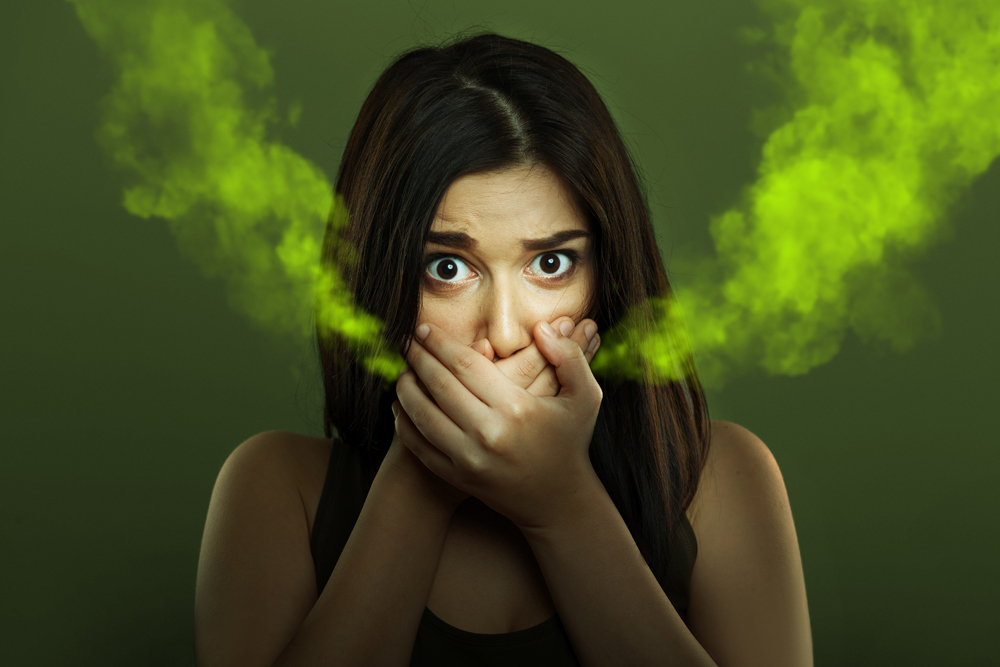Halitosis: 7 Myths Debunked!

Dr Andrew Doig was recently featured in an article for For Life magazine discussing various myths regarding bad breath (https://www.forlifemag.com/top-7-bad-breath-myths-debunked/). In this blogpost, we wanted to revisit these myths, and to further explore the impact of bad breath.
Only a fraction of halitosis stems from the stomach. When it does, the association is usually indirect. In 90% of cases, halitosis is caused by anaerobic bacteria breaking down food in the mouth, where they create smelly volatile sulphur compounds (VSCs).
These compounds can lodge in the tongue and gums, resulting in bad breath through:
- Tongue coating – the back of the tongue has a large irregular surface, making it ideal for anaerobic bacteria and VSCs. Unfortunately, the back of the tongue is not easily accessible for cleaning, making this condition difficult to treat at home.
- Gum disease and oral diseases – patients with gum disease often have bad breath because gum pockets are not only ideal for VSC production, but also because VSCs accelerate tissue breakdown, creating further foul odours. Gum disease patients are also more likely to have tongue coating than healthy patients. Oral diseases associated with halitosis include ulcerative gingivitis (painful gum infection due to bacterial overgrowth), dental abscesses, pericoronitis (gum infection around the wisdom teeth) and oral candidiasis (yeast infection of the oral mucosa).
- Other reasons – dry mouth, dehydration and hunger, oral wounds and poor oral hygiene in patients with braces and dentures may also be causes.
Halitosis may be a reflection of underlying conditions in approximately 10-20% of cases. The type of health issues include:
- Diabetes
- Insufficiencies of the liver, pancreas or kidneys
- Respiratory tract infections
- Side effects from medications
Less than 0.5% of halitosis is associated with stomach disorders such as gastroesophageal reflux disease (GERD) or H.pylori infection.
Most people can’t tell they have bad breath as they’ve probably adapted to such odours over time. Plus, our noses and mouths communicate through an opening at the back of the mouth, making smelling our own breath difficult. In pandemic times however, people have become more aware of their breath when wearing masks, as dried oral moisture droplets leave an odour on the insides of masks.
To confirm the presence of bad breath, I recommend:
- Asking your dentist/someone you trust to smell your breath.
- Licking the back of your hand, letting it dry, and sniffing it. Otherwise, breathe through your mouth into a cupped hand; you should be able to smell your breath.
Comparing the smell of the mouth breath versus your nose breath can give a clue as to whether the cause of your halitosis is oral or extra-oral. Nose breath smells are a reflection of compounds in the bloodstream which are released through the lungs, and may be a sign of underlying disease. Mouth breath smells are usually a reflection of intraoral causes.
The quality of the smell is also useful in helping to identify specific causes of bad breath. For example, a patient who is on a protein-based diet may have “Keto breath”, which takes on a very strong fruity smell. The breakdown of proteins in their diet causes acetone to be released into the person’s bloodstream, which then is released through their urine and breath. This same compound is responsible for the acetone-like breath in diabetics, due to the high levels of ketones in the bloodstream.

The type of bad breath these foods cause is transient and tends to go away after a few hours.
Some foods such as spices, garlic and durian are broken down and absorbed into the blood stream. They are then released into our surrounding air as we breath through our noses. Other examples of transient halitosis is morning breath due to reduced saliva flow when we’re sleeping, and after consuming alcohol or smoking cigarettes.
Bad breath that is caused by foods can usually be masked with breath mints (sugar-free of course), and more frequent toothbrushing and mouth rinsing. Avoiding particular foods before important meetings or social engagements would be a simple and effective strategy to avoid transient halitosis.
Tongue coating is considered the most important contributor to halitosis levels (Wu et al. 2019), but brushing and scraping the tongue ALONE will not be enough to keep bad breath away. However, in conjunction with other measures such as efficient toothbrushing at least twice a day, use of floss and interdental brushes, as well as staying hydrated by drinking
Here are a few products for controlling halitosis:
- Tongue scrapers – these can be effective. You can also use a toothbrush to brush the entire tongue, focusing on the back of tongue as that’s where most VSC-producing bacteria is found.
- Mouthwashes that carry out the following actions:

Anti-bacterial action:
- Mouthwashes that reduce the number of anaerobic bacteria which cause the smelly odour.
- Ingredients such as Chlorhexidine gluconate and cetylpyridine chloride.
- Chlorhexidine gluconate is a broad spectrum antibacterial agent, and is able to eliminate bacteria that produce VSCs.
- The most common formulation of this compound is a 0.12% oral rinse (Peridex®, Perioguard®), and these are only available when prescribed by your dentist.
Ingredients that affect Volatile Sulphur Compound (VSC) formation
- Chlorine dioxide / sodium chlorite
- Zinc compounds: Zinc is able to inhibit the bacterial breakdown of proteins, and hence VSC production.
- Colgate Plax®, Crest Pro-Health® and Breath Rx®
Care should be taken when using mouthwashes with Chlorhexidine as side effects include reversible staining of the teeth and mucosal surfaces, as well as altered sensation of taste. Please do take advice from the prescribing dentist regarding the directions for use.
Mouthwashes, mints and chewing gums are not able to eliminate halitosis permanently, but are able to freshen our breathes for a certain period of time. As long as the cause for the halitosis is not eliminated and poor dental cleaning habits still exist, the source for production of VSCs is still present.
The types of dental treatment that contribute to permanently eliminating halitosis include:
- A thorough dental and medical history with diet analysis and identification of personal habits such as smoking and alcohol intake
-To make sure there may not be any underlying possible extraoral cause for the halitosis
-To check medications and possible side effects these can create such as dry mouth - Intraoral halitosis can be eliminated by scaling, root planing and detailed oral hygiene instructions. These procedures act to effectively reduce the VSC-producing bacteria in the mouth. However, it’s important to bear in mind that the patient will need to maintain good oral hygiene measures at home as all surfaces in the mouth, once cleaned, will become recolonised by commensal bacteria.
- Removing dental decay, replacing faulty or leaking restorations, and eliminating active infections such as pericoronitis is necessary for permanent reduction in halitosis.
This is definitely not true. Since 90% of halitosis is caused by poor oral hygiene, diligent home care alone should be sufficient in controlling bad breath. If halitosis persists, you should speak to your dentists about:
- Effective home care measures – consult your dentist about how you can improve your oral hygiene
- Potential intra-oral diseases – a thorough examination can determine the cause of your condition and whether you need treatment such as scaling, root planing, or dental decay and gum infection treatment to eliminate the source of your bad breath.
- Potential extra-oral causes – if intra-oral causes of bad breath have been eliminated, your dentist may refer you to a medical specialist as extra-oral halitosis may be a sign of an underlying medical condition.
This article was written by Dr Andrew Doig for Skye Dental. We thank For Life Magazine for including Dr Andrew in their article entitled, “Top 7 Bad Breath Myths Debunked”.
https://www.forlifemag.com/top-7-bad-breath-myths-debunked/
